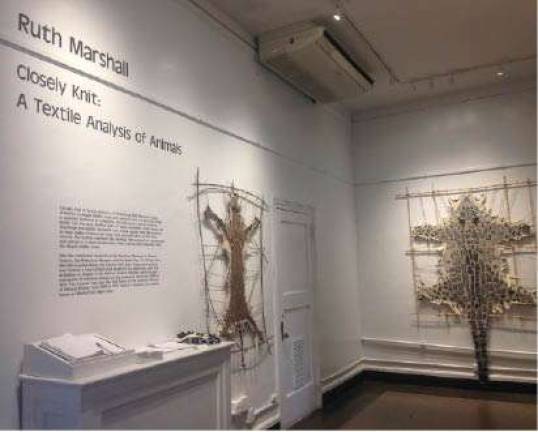Walk on the Wild Side

Art exhibit raises awareness about endangered species
Central Park Australian artist Ruth Marshall can blame her interest in animals on her day job.
In 1995, she started working at the Bronx Zoo as an exhibit sculptor, where she painted murals, built faux rocks and crafted rubber vines. A graduate of the Pratt Institute's Master of Fine Arts program in Brooklyn, she needed a job in her field in order to extend her student visa.
While at the zoo, she became fascinated with the animal collections, but the former sculpture student wasn't sure how to incorporate that interest into her artwork-until she picked up a pair of knitting needles.
Now Marshall, whose mother and aunt taught her knitting when she was young, creates life-size textile pelts of animals endangered by illegal wildlife trade. Her current exhibition, "Closely Knit: A Textile Analysis of Animals," at the Arsenal Gallery in Central Park, includes to-scale, knit renderings of actual tiger, ocelot and leopard pelts stretched on wooden frames as though they were drying in the sun. The exhibit highlights the severity of the illegal skin trade, but, Marshall said, also uncovers the beauty of the animals that she discovered while a zoo employee.
As research, Marshall gained access to the American Museum of Natural History's collection of animal pelts, which are stored behind the scenes at the museum on 79th Street, just across the park from the Arsenal building. She measured every stripe and spot and sketched the intricate patterns of the tiger and ocelot coats on large pieces of grid paper. Once she completed her sketch, she set to work hand-knitting the recreations, a laborious process that can take four months.
"Nobody sees these pelts at the museum, and actually nobody's really that interested in them," she said. One of her pieces recreates a Russian tiger pelt the museum acquired in 1930; the female tiger was tracked and killed after hunters found its footprints in the snow.
"I like the idea of bringing the story of the animal out of the drawers or the cupboards of the museum," she added. "The stories of these individual animals are just kind of forgotten or stored away in the mammal collection."
For the show, Marshall also knit the pelt of a living animal: the snow leopard, Askai, at the Central Park Zoo, located next door to the Arsenal building. The knitted pelt references Askai's possibly tragic fate, if he were living in the wild.
Though she sells her pieces-the pelts in the exhibit range from $7,000 for an ocelot to upwards of $12,000 for a nearly nine-foot tiger-she struggles to find buyers.
"It has to be a pretty unique person that's going to buy a real-looking thing that big to put on the wall," she said.
She did sell a knitted Amur leopard pelt to "eccentric" Turkish collectors recently. The leopard, native to the Russian Far East, has been widely poached for its thick, spotted fur coat and is one of the world's most endangered species. According to the World Wildlife Fund, approximately 30 Amur leopards exist in the wild. Marshall sold the knit pelt for $14,000, more than a real, black market pelt sells for, she said, which led her to wonder if artistic replications could offer substitutes for illegally-traded pelts.
"People really go on a journey when they see my work," said Marshall, who lives in the Bronx and whose landlord is the lion keeper at the Bronx Zoo, where she worked until 2009. "They see it from a distance; they think it's real; they're horrified. I think that's the tricky thing with selling my work. Everybody understands that nobody does this anymore. It's completely not acceptable to put a hunter's trophy on the wall. But then if they do allow themselves to sort of come closer?then they have to reassess. Then they sort of appreciate not just the craftsmanship, but there's an immediate understanding of how beautiful this animal is, and how having endangered species is a tragedy."